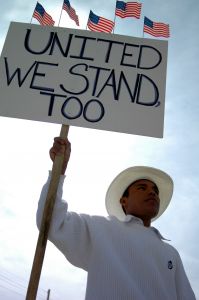Enthusiasm High among Colorado Latinos—Is it time for a new narrative?

 By Rob Preuhs, Latino Decisions
By Rob Preuhs, Latino Decisions
The Latino vote will help determine the presidential election. If one is not convinced, playing around with the Latino Decisions’ Latino Vote Map for a few of the battleground states with a sizeable Latino population ought to change your mind. The basic equation for each state is quite simple: the marginal (dis)advantage for one of the candidates among Latino voters multiplied by the Latino proportion of the electorate equals the net effect of the Latino vote. The Latino effect thus comes down to two variables—marginal group preferences and relative turnout. If one approaches zero, the Latino effect approaches zero. And in a state like Colorado, now one of the closest battleground states with a sizeable Latino population, how this equation plays out quite possibly determines who passes the 270 point in the Electoral College.
 This should not be a groundbreaking insight as the narrative of Colorado electoral politics has included a prominent role for Latino voters for quite some time. Yet this year’s storyline has focused less on the preference portion of the equation and more on the potential for low turnout. Indeed, this author answered more than one request for a comment on the Latino voter effect by noting low levels of enthusiasm among Latinos in Colorado and thus anticipating a smaller effect in 2012 than in 2008. Lack of movement in immigration reform, the disproportionate effect of the economic downturn on Latinos, and a reversion to the mean all seem (or seemed like) plausible explanations for such an expectation.
This should not be a groundbreaking insight as the narrative of Colorado electoral politics has included a prominent role for Latino voters for quite some time. Yet this year’s storyline has focused less on the preference portion of the equation and more on the potential for low turnout. Indeed, this author answered more than one request for a comment on the Latino voter effect by noting low levels of enthusiasm among Latinos in Colorado and thus anticipating a smaller effect in 2012 than in 2008. Lack of movement in immigration reform, the disproportionate effect of the economic downturn on Latinos, and a reversion to the mean all seem (or seemed like) plausible explanations for such an expectation.
Yet, new polling data from America’s Voice/Latino Decisions’ September/October 2012 Colorado Latino Voter Survey might just change this narrative leading up to election. The changing narrative is not, however, about preference margins. As Figure 1 shows, Obama holds a solid advantage over Romney, with 74% of respondents leaning, likely or certain to vote for Obama and this number has not changed much since the June Battleground poll. The first variable in the Latino Effect equation is a rather stable 40-45% net marginal preference for Obama (conservatively estimated and accounting for the margin of error).
Preferences are only half the equation. What about enthusiasm and the potential for high (or low) Latino turnout? Well, contrary to the narrative of a disappointed or disillusioned Colorado Latino electorate, the Sept./Oct. 2012 data suggest a reasonably high level of enthusiasm for the election and perhaps more important, a majority of Latino voters who are even more enthusiastic for this election than they were for the 2008 election. When asked, “Thinking ahead to the November 2012 presidential election, how enthusiastic are you about voting in the election next year?,” 69% said they were “very enthusiastic,” 23% were “somewhat enthusiastic,” and 4 and 3 percent were “not too” or “not at all” enthusiastic, respectively. With almost 70% of respondents very enthusiastic, it is hard to construct a narrative of an apathetic Latino electorate. Another question gauged enthusiasm relative to the 2008 election with similar results.[1] 54% of respondent said they were more enthusiastic in 2012 compared to 2008, and another 22% said their level of enthusiasm was the same as the 2008 election which was characterized by one of the largest surges in Latino voter turnout and enthusiasm of any recent presidential election (that’s quite a high bar). In short, enthusiasm is quite high among Colorado Latinos. And, as Figure 2 shows, enthusiasm increased from the June Battleground Poll—by almost 10 percent for the most enthusiastic responses in each question.
We can also look more closely at enthusiasm among Presidential preference categories and partisan orientations to see if one segment of the Latino electorate and their preference margins are driving enthusiasm. Figure 3 presents the overall enthusiasm responses for those reporting to be certain to vote for Obama or Romney, as well as party identifies, and independents.
Figure 4 does the same for the responses to the question measuring enthusiasm relative to 2008. Overall enthusiasm (Figure 3) is consistent across these groups, with the exception of independents who are generally less enthusiastic about elections (one of those consistent patterns of voter behavior identified by political scientists). There is nothing here to really suggest a startling lack (or disproportionately high) level of enthusiasm for any segment. Relative enthusiasm shows some variation, however, with Latino Republicans and Romney supporters demonstrating a higher level of 2012 vs. 2008 enthusiasm compared to Democrats and Obama supports. This may be the enthusiasm gap, but given that adding the “same/no different” responses for Democrats and Obama supporters roughly equals the Republican and Romney relative enthusiasm totals, respectively, perhaps this is only an aberration resulting from the hyper-enthusiasm levels of 2008. If Latinos are as or more enthusiastic about 2012 than 2008, it’s hard to point to a drop in enthusiasm. (And combined, the June poll revealed 70% of respondents reported enthusiasm at the same or higher levels than in 2012).
At least in Colorado, the September/October data undercuts the narrative of a disillusioned and unenthusiastic Latino electorate. Overall enthusiasm seems high, among most groups, and majorities of Obama and Romney supporters are more enthusiastic than in 2008. Moreover, three-fourths of Latinos report similar or greater levels of enthusiasm in 2012—a pretty remarkable level of enthusiasm given the high bar set in 2008. So, what explains the traction of the low enthusiasm narrative? National numbers do support such a story. But in battleground states, higher enthusiasm and participation rates are expected among the overall electorate as competitive elections generally lead to both, and Latinos do not seem to be an exception. All voters, including Latinos, are quite simply cued to the importance of their electoral context and are appropriately responsive to such a context. Other factors, such as Obama’s DHS directive and Romney’s reply, and simply temporal proximity, add to list of potential enthusiasm boosters.
In the end, the simple Latino voter effect equation should look a lot like 2008 in Colorado if enthusiasm levels are a reasonable proxy for November turnout. And, while other factors may still dampen turnout among Latinos a bit, the Latino impact on Colorado’s presidential election should be of a similar magnitude as in 2008. Perhaps it’s time for a new narrative of Latino voter impact in Colorado.
The commentary of this article reflects the views of the author and do not necessarily reflect the views of Latino Decisions. Latino Decisions and Pacific Market Research, LLC make no representations about the accuracy of the content of the article.
This article was first published in Latino Decisions.
Robert R. Preuhs is an Assistant Professor of Political Science at Metropolitan State University of Denver. He has published numerous articles on state politics and minority representation. His most recent article, co-authored with Eric Gonzalez Juenke,“Irreplaceable Legislators? Rethinking Minority Representatives in the New Century” appears in The American Journal of Political Science.
[Photo by stock.xchng]




